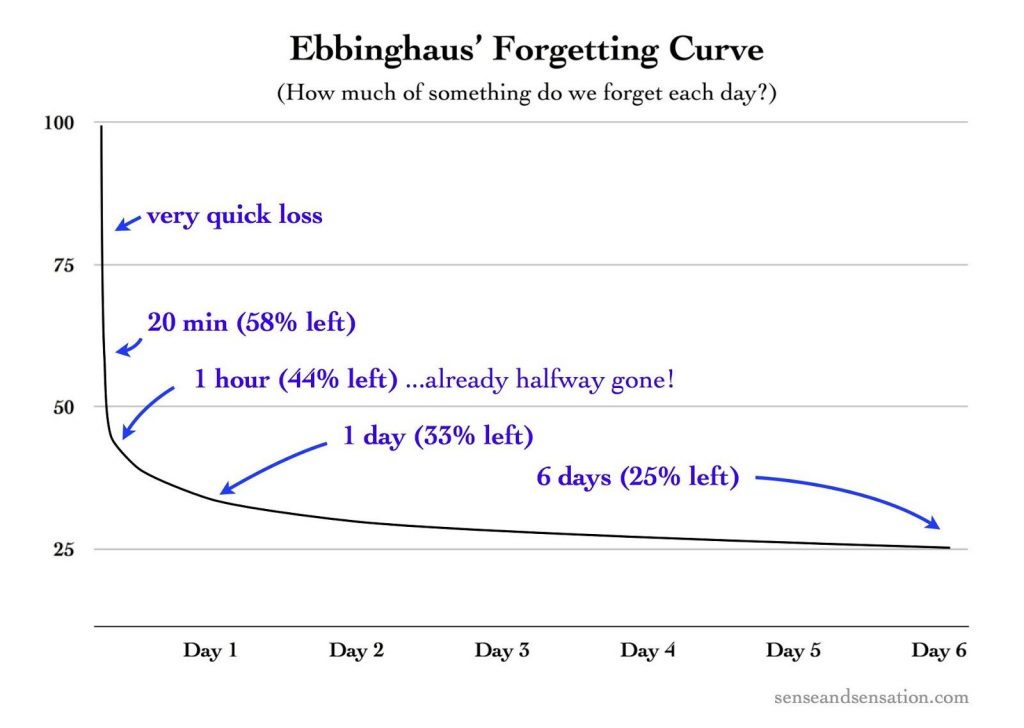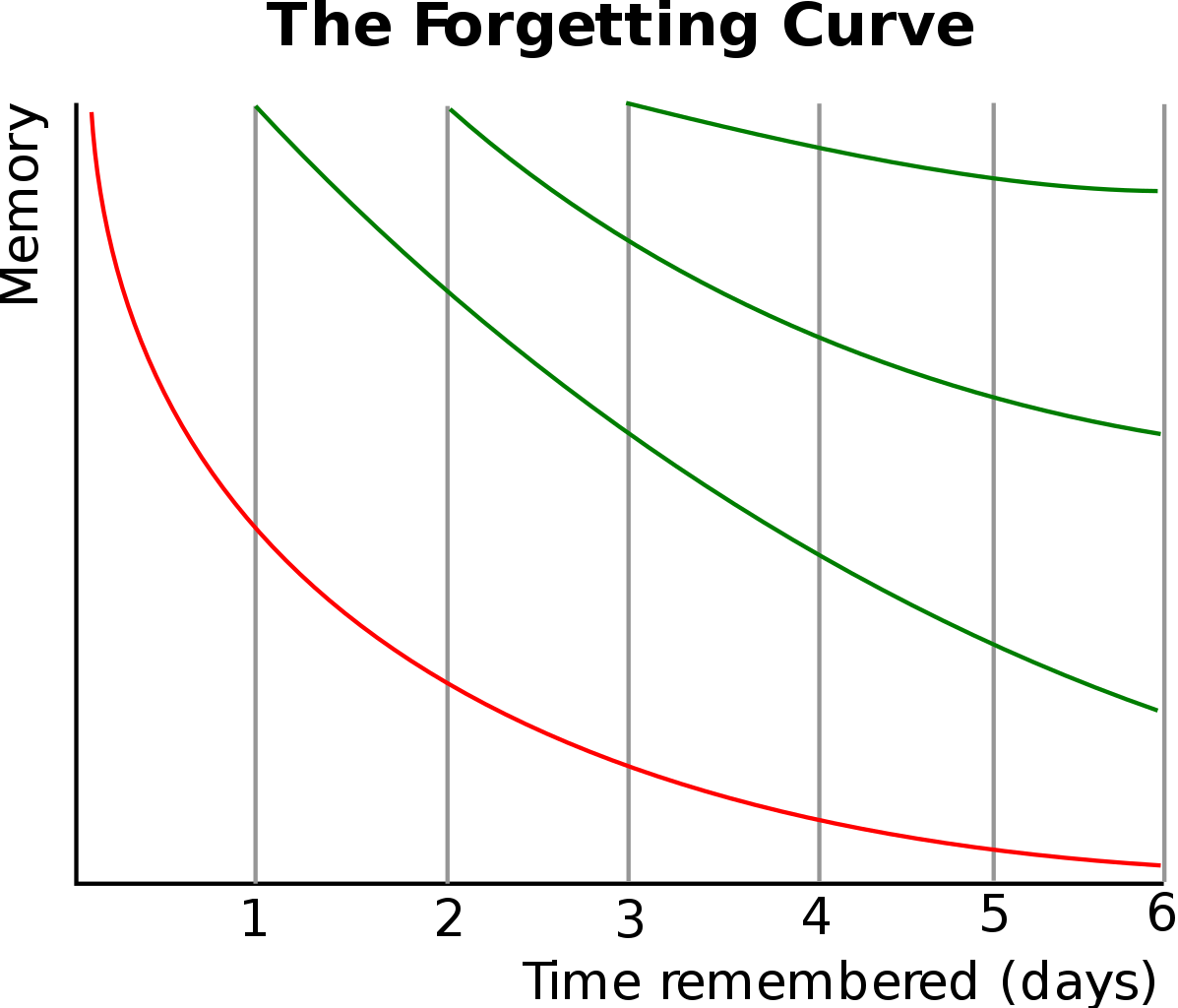9
Forgetting happens in all of us. Davis & Zhong (2017) write that there are three mechanisms for passive forgetting, “(1) loss of context cues across time that make retrieval difficult, (2) interference during retrieval from other similar memories accumulated across time, and (3) the “natural” decay of memory traces from the general instability of biological materials and the passage of time.” There are also forms of active forgetting such as:
“Interference-based forgetting … other competing information or activities before (proactive) or after (retroactive) the learning event accelerate the decay of memory traces. Motivated forgetting occurs when cognitive mechanisms are voluntarily engaged to weaken memory traces, often because the memory has some unpleasant quality. Retrieval-induced forgetting … occurs when some aspects of a memory are recalled that suppress the recall of other aspects related to the recalled memory” (Davis & Zhong, 2017).
Research suggests that forgetting is a default process in the brain. Memory consolidation is “in constant competition with a “homeostatic” signal from intrinsic forgetting, with the fate of newly acquired memories being determined by the winner” (Davis & Zhong, 2017). The brain downgrades and works on removing information that is no longer useful – to make space for new learning (Rosenzweig et al., 2002). The Forgetting Curve (Davis & Zhong, 2017; ; Stahl et al., 2010, Murre & Dros, 2015) estimates how much information about an experience is lost over time. Studies of the forgetting curve are often based on information that does not have much meaning associated with it (e.g. low emotional value) but shows how our learning decays rapidly. Within 20 minutes, we lose about 40% of what we learned. After a third of the day has passed, we lose 70%. The key point is that forgetting happens. It’s a default process. New learning interferes with what we previously learned. And unused learning decays. Why does this happen? Why do we forget so much? “Active forgetting, along with attention, acquisition, and consolidation, is thus part of the brain’s biological system for managing memories” (Davis & Zhong, 2017). The brain has to make space and free up resources for new learning. So, we forget.

In our brains, space is limited, energy is limited, biological materials are limited – we can’t keep everything. So we are constantly making space. Our brain is constantly forgetting so what’s meaningful remains accessible. As a result, information without much meaning is forgotten rapidly. Most is forgotten within an hour. Forgetting is a default process in the brain meaning that we don’t have to do anything for it to occur. But we have to do something to prevent it from occurring – at least in relation to the information we do not wish to forget. How can we flatten out the forgetting curve and forget less? With repetition (e.g. reconstructing the memory, reactivating the brain’s networks that hold the information we learned). The more frequently we reconstruct a memory the longer that memory will last. Each reconstruction reduces the rate of forgetting – the forgetting curve gets flatter. Why? High frequency items are deemed more meaningful in the brain. This process of repeated activations strengthens connections and reduces forgetting. In other words, by having something appear more frequently we increase the meaningfulness assigned to it. Reconstructions are best facilitated with retrieval activities (i.e. by having to reconstruct as much of the memory as possible). We reconstruct what we can and then check to see what is missing and elaborate on what we’ve retrieved. In sum, the more unique instances a memory is reconstructed, the more meaning assigned to it and the less it becomes forgotten.

References
Forgetting – A Default Process
- Davis, R. L., & Zhong, Y. (2017). The biology of forgetting—a perspective. Neuron, 95(3), 490-503.
- Rosenzweig, E. S., Barnes, C. A., & McNaughton, B. L. (2002). Making room for new memories. Nature neuroscience, 5(1), 6-8.
- Durazo-Arvizu, R., & Plange-Rhule, J. (2016). Metabolic acceleration and the evolution of human brain size and life history. Nature, 533(7603), 390
- Stahl, S. M., Davis, R. L., Kim, D. H., Lowe, N. G., Carlson, R. E., Fountain, K., & Grady, M. M. (2010). Play it again: The master psychopharmacology program as an example of interval learning in bite-sized portions. CNS spectrums, 15(8), 491-504.
- Murre, J. M., & Dros, J. (2015). Replication and analysis of Ebbinghaus’ forgetting curve. PloS one, 10(7).
Media Attributions
- 1197px-ForgettingCurve.svg
